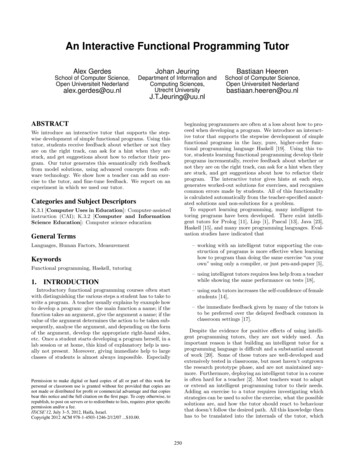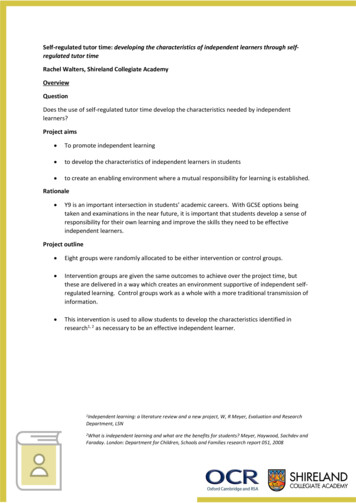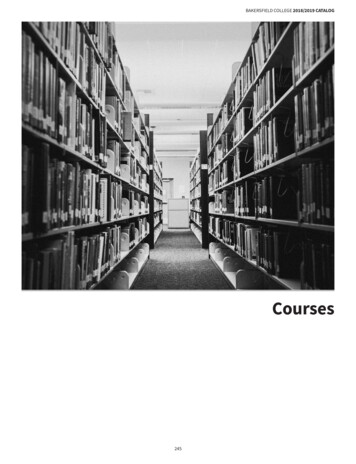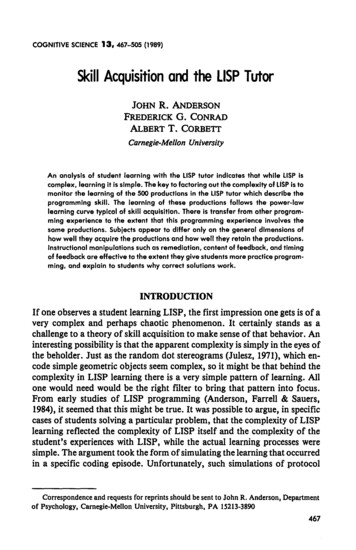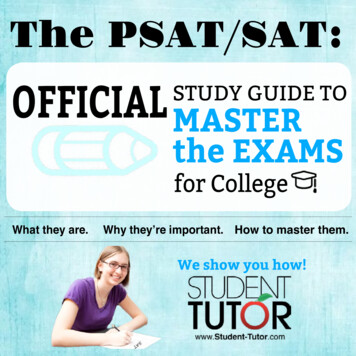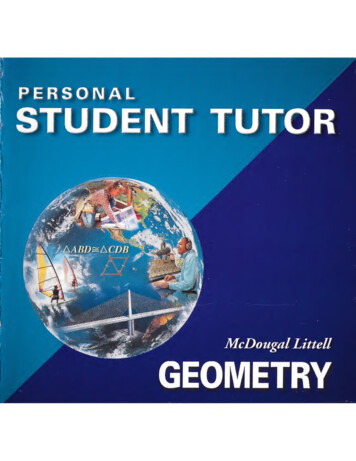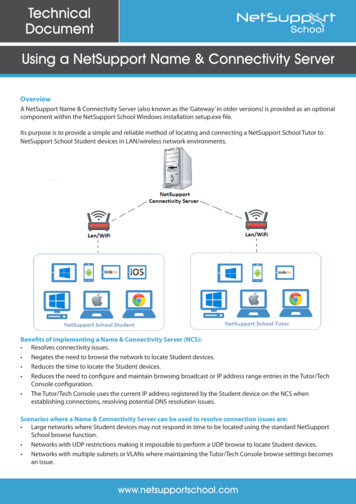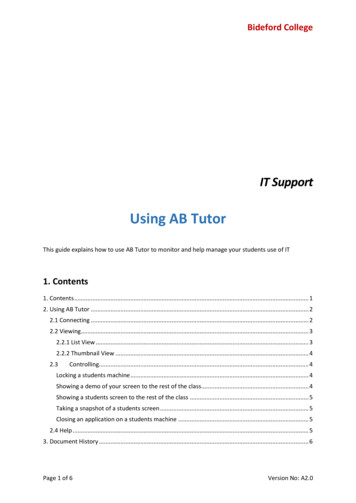
Transcription
TOJET: The Turkish Online Journal of Educational Technology – October 2016, volume 15 issue 4Use of Intelligent Tutor in Post-Secondary Mathematics Educationi the United ArabEmiratesAnita DaniHigher Colleges of Technology, United Arab EmiratesAnita.Dani@hct.ac.aeRamzi NasserDhofar University, Sultanate of Omanrnasser@du.edu.omABSTRACTThe purpose of this paper is to determine potential identifiers of students’ academic success in foundationmathematics course from the data logs of the intelligent tutor Assessment for Learning using Knowledge Spaces(ALEKS). A cross-sectional study design was used. A sample of 152 records, which accounts to approximately60% of the population, was extracted from the data-logs of the intelligent tutor, ALEKS. Two-step clustering,correlation and regression analysis, Chi-square analysis and ANOVA tests were applied to address the researchquestions. The data-logs of ALEKS include information about number of topics practiced and number of topicsmastered by each student. A derived attribute, which is the ratio of number of topics mastered to number oftopics practiced is found to be a predictor of final marks in the foundation mathematics course. This variable isrepresented by the name mtop. Cluster classification based on this derived attribute resulted into three groups ofstudents for which the mean values of the variable mtop are 0.80, 0.66 and 0.53 respectively. A moderatelystrong, positive and significant correlation was found between mtop and the final exam marks.Keywords-cluster analysis, intelligent tutor, learning analytics, ALEKSINTRODUCTIONIt has been reported that many students spend a greater period of time in early years of the higher educationespecially in remedial or foundation programs; they spend more than expected without achieving the programrequirements (Nasser, 2012). As Hansen et al (2006) explain, that secondary schools prepare students foruniversity requirements but do less in preparing them to achieve at the level that universities require.Significantly, English language appears to be a difficult subject as most universities use that medium ofinstruction to teach science and non science subjects. Many students in the Gulf countries have not achieved alevel of competency to enable them to successfully operate in English as a language of instruction and learning.Many programs, techniques, and methods are in place to support foundation year students in their learning inhigher education among them is continuous assessments and review which are probably one of the keyingredients to improve student learning strategies to be used for enriching their learning experience as it has thecognitive as well as the motivational purpose (Ritter, Anderson, Koedinger & Corbett, 2007). Timely feedbackin assessments fills the gaps between the actual learning and expected learning outcomes (Chappuis, 2014).Formative assessment with feedback is particularly significant when students are uncertain about what isexpected of them and when they need instructional guidance about how to move ahead (Nguyen, Hsieh & Allen,2006; Wood & Wood, 1996). One claim is that the process by which students are monitored during instructioncan help teachers provide timely feedback on students’ actual learning.While formative assessments or continuous assessments followed by feedback can be used periodically to assessstudents’ learning, it may not be feasible or practical to incorporate in large class sizes, (Chappuis, 2014). Thefirst years in higher education, a great deal of stress is placed on the instructor to carry out continuousassessments, or formative assessments and provide timely feedback. More lately the use computer-basedassessment systems known as intelligent tutoring are widely used in secondary schools and higher education.These systems are web-based and designed to run on multiple devices such as laptops, iPads and mobile gadgets.They can be used to conduct frequent formative assessments with appropriate and timely feedback to minimizethe gap between actual learning and expected learning (Narciss & Huth, 2004). It also engages students inauthentic learning opportunities and can increase student participation and motivation in the learning process(Miller, 2009).Copyright The Turkish Online Journal of Educational Technology152
TOJET: The Turkish Online Journal of Educational Technology – October 2016, volume 15 issue 4A key feature of these software systems is their ability to record and store every learning activity occurring whena student interacts with the system. The data gathered for every user can be analyzed providing the “learningprofiles” for each student or at the aggregate level. A learning profile is useful to understand students’ studyhabits and their progress (Kotsiantis, Tselios, Filippidi & Komis, 2013). Learning profiles can be detected byapplying methods of Learning Analytics in which system-generated large data logs are analyzed in order tounderstand students’ learning activities (Siemens & Long, 2011). The data generated support instructors toassess where the students are and where to go forward.LITERATURE REVIEWComputer based assessmentsIn class, the instructor can engage students in student-centered activities in the classroom through intelligenttutors. Students can access such systems online at any time or anywhere, for which they are expected to developself-regulatory approaches to succeed and use the technologies available to them in and outside the classroom(Aleven, Roll, McLaren, Koedinger, 2010; Nicol, 2006; Nguyen, Hsieh & Allen, 2006). Web-based intelligenttutoring systems allow students to practice, to have control over their learning and manage their time andinteraction with peers and instructors (McArthur & Stasz, 1990). Also the use of online computer basedassessments, have several advantages over paper based assessments (Aleven, Roll, McLaren & Koedinger, 2010;Balacheff & Kaput, 1996; Hagerty & Smith, 2005), they provide access to any number of students anytime andanywhere through any type of computer, such as a laptop, tablet or a smart phone. They provide a wider range ofassessment techniques than the paper based assessments, for example, inclusion of graphics and multimedia.Students can provide their responses in various formats, such as drawing graphs on a digital screen, locatingnumber positions on a number line by clicking on the webpage. The most significant aspect of computer basedassessments is that individualized feedback is given instantly. More importantly, the software applications cangenerate questions randomly from a large bank of questions and different versions of assessments produced totailor different levels of learning outcomes and practice questions required for mastering a topic (Shute &Underwood, 2006). Moreover, such web-based software can foster student-centered learning by engagingstudents in meaningful learning activities and can increase students’ engagement in learning (Chen et al, 2008;Chen, Yunus, Ali & Bakar, 2008; Nguyen, Hsieh & Allen, 2006; Schneider, Egan & Julian, 2013).Intelligent tutorsGenerally, a computer tutor or intelligent tutor establishes task-related goals and guides the learner toward thegoal. An expert tutor is capable of designing learning tasks to ensure that the student persists on the task andgains some new knowledge, the student when interacting with the computer tutor may heavily rely on the systemto work out a problem as an act of educational transference (Thelwall, 2000). While early computer-basedlearning was based on behaviorist learning theories that each application is taught as a separate learningobjectives, into modules with separate objectives that are linked in such a way that the outcomes in one modulecan be used as an input into another. However more recent advances in cognitive sciences recommend adaptingthe constructivist learning theory and emphasize that “true” understanding as connected and generalizableknowledge wholes (Ritter, Anderson, Koedinger & Corbett, 2007). According to constructivist learningparadigm, a student could cultivate independent and self-directed learning and higher ordered thinking.Researchers as Chen, Yunus, Ali & Bakar (2008) and McArthur & Stasz (1990) have shown that computerbased or web-based assessments had positive effects on students' mathematical learning processes especiallywhere problems required analytical and critical approaches for solving them. In mathematics immediatecorrection and feedback can generally have substantial real-time benefits to students as it gives them anopportunity to analyze the problem and readjust, reorganize, restate, and recalculate the problem work and moveto higher levels of the taxonomy of educational objectives.The current and emerging technologies, such as intelligent tutors, which are supported by artificial intelligencetechniques have an advantage compared to other information technologies (Chen, Yunus, Ali & Bakar 2008;Chen et al, 2008; McArthur & Stasz, 1990; McGatha, & Bush, 2013). The intelligent tutors have the ability tointegrate more than one medium, provide authentic and concurrent learning activities and provide academiccontent based support to a large student body. As reported in (Stiggins, 2001; VanLehn, 2011) human tutoringhas an effect size of d 2.0 relative to classroom teaching without tutoring. This effect is known as the ‘twosigma gain’. Developers of intelligent tutors work towards achieving the same effect as human tutors byincorporating multidimensional tutoring with appropriate feedback and scaffolding techniques based on theknowledge of the subject and the knowledge of student’s state of learning (Kao & Lehman, 1997; Stiggins,2001). Intelligent tutors’ development is based on combining theories of cognitive science and techniques ofartificial intelligence (Anderson, Boyle, Corbett & Lewis, 1990; Ritter, Anderson, Koedinger & Corbett, 2007;Copyright The Turkish Online Journal of Educational Technology153
TOJET: The Turkish Online Journal of Educational Technology – October 2016, volume 15 issue 4McGatha & Bush, 2013; Miller, 2009). The intelligent tutors can provide interactive and personalized learningenvironment for students allowing them to study and learn individually (Hagerty & Smith, 2005).Some intelligent tutoring system, such as Cognitive tutor, allows students to write solutions procedurally as ifthey were solving it on paper. The system gives feedback on each step as well as for the overall solution (Ritter,Anderson, Koedinger & Corbett, 2007) whereas, intelligent tutors like ALKES (Assessment for Learning usingKnowledge Spaces), provides feedback only on the final answer. Cognitive tutors are appropriate for novicelearners where every step is supported through feedback, use of systems like ALEKS is appropriate in highereducation where students are expected to develop the ability to follow through problem-solving procedures withminimal support.One of the prominent theoretical frameworks underlie the development of intelligent tutoring systems, is theframework of knowledge space theory. The knowledge space theory is applied to make the learner agile tolearning. Tutoring systems, such as ALEKS, is built on the foundations of knowledge space theory that cangauge the level of student’s understanding and can detect the correctness of student’s next response on the basisof current response. ALEKS provides learning goals, scaffolding support for learning and allows for formativeand continuous assessments and feedback.At the core of the analytic engine is the concept of two fringes. One fringe which consists of all topics that Whata Student Can do and the second fringe consists of all topics that the student is Ready to do or Learn. Refer toTable 1 for illustration.Table 1: Two states of student’s learning (excerpt only)What H00298326 Can Do as of 09/15/2014What H00298326 Is Ready to Learn asof 09/15/2014Place Value, Expanded Form, and NumeralExponents and Order of OperationsTranslationNumeral translation: Problem type 1Writing expressions using exponentsALEKS is user friendly and interactive. A student can choose any topic available from the list of ‘Ready toLearn Topics.’ A question is presented on that topic by the system, a student can request an explanation and if astudent can respond to the problem correctly, positive reinforcement is prompted on the system. If the studentcan answer three more similar questions correctly, then the system allows the user to terminate the task byprompting the option of ‘Done.’ If a student is confident about the mastery of this topic then, they can click onthe button ‘Done,’ and the topic is added to the list of ‘what a student can do.’ If a student cannot answer three tofour consecutive questions correctly, then the system does not present questions from the same topic but suggeststhat the student can try another topic. ALEKS has the ability to create individualized sequence of topics based onthe student’s background knowledge and level of cognitive development but the instructions provided byALEKS are static and same for all students irrespective of their individual learning styles. It does not provideinstructions in different multi-media format, such as audio or video, but allows instructor to upload presentationsand video files customized for students.ALEKS sets two types of in-built and individualized assessments known by the progress test and comprehensivetest. These assessments include questions from the two sets, the first, a set of topics mastered by the student andthe set of topics which the student is ready to learn. Progress tests are administered by the system based on thetopics mastered and time spent by the student, whereas comprehensive tests must be assigned by the instructor.The purpose of the progress test is to ensure that students can retain and recall his or her learning. Thus bydiagnosing student’s current state of knowledge, the software can provide scaffolding exercises and/or problemsthat help the student progress gradually. Each student can learn at her own pace and monitor her own progress.Inclusion of ALEKS in the foundation mathematics curriculum is aligned with the strategic decision of ministryof higher education in the United Arab Emirates (UAE) to basically integrate computer-based technologies in theeducational processes.Learning AnalyticsLearning analytics focus on deriving information which can reveal how students use the intelligent tutoringsystems and identify potential “identifiers” of academic achievement. (Desmarais & Baker, 2012; Holden,Sottilare, Goldberg & Brawner, 2012; Kotsiantis, Tselios, Filippidi & Komis, 2013; Libbrecht, Rebholz,Herding, Müller & Tscheulin, 2012). Application of methods of learning analytics can be a powerful means toinform and support learners, teachers and their institutions to better understand and predict individualizedlearning needs and performance (Greller & Drachsler, 2012; Siemens & Long, 2011, Tempelaar, 2014). ThereCopyright The Turkish Online Journal of Educational Technology154
TOJET: The Turkish Online Journal of Educational Technology – October 2016, volume 15 issue 4are specific student attributes when analyzing learning patterns, such attributes include time – spent on a topic,engagement with it and other system dispositional elements as skills and computer agility (Siemens & Long,2011). Such system specific attributes are taken into account for analyzing students’ learning patterns or theirengagement in learning, but in some cases new attributes are derived to gain deeper understanding ofdeterminants of students’ learning (Antonenko, Toy & Niederhauser, 2012). Learning analytics attributes can bederived by combining the information about the number of topics practiced, time spent on learning and numberof topics mastered. This analysis could provide information about whether a student can learn from theinstructional queues and feedback provided by the software and utility for mastering the course content.The system-specific attributes generated by ALEKS may not provide accurate information about student’slearning efforts as the system cannot indicate the idle time, when students login to the system and do not attemptto respond. In addition, the time taken to master a topic is not signified as students are encouraged to learn attheir own pace. It is worth investigating how to detect from such large data logs, information about students whoare able to master a topic by studying independently.We calculated the ratio of the two variables number of topics mastered and number of topics practiced,represented by the variable mtop (which is an abbreviation of mastered-to-practiced) which can be used as aconstruct of the extent of which the student has the ability to learn independently. The aim of this research is toexamine whether mtop is a predictor of student’s assessment in a course.Course StructureIn the context of the UAE not too long ago, the ministry of higher education of the UAE took a decision tosupply tablets to foundation year students in all federal higher education institutions. This decision was taken toaddress the strategy to develop technologically advanced environments to support learning in higher education(Gitsaky, Robby, Hamdan & Ben-Chabane, 2013). The supply of tablets to the foundation year students as thefirst year experience was perceived as an impetus for students to “ride” the information age and stay abreast ofthe technological advancement in higher education in preparation for the workplace (Nguyen, Hsieh & Allen,2006; Yorke & Longden, 2004).Two foundation courses covering basic arithmetic, algebra, geometry and statistics are delivered using theALEKS software used tablets. Students use their tablets (iPads) to access this program. The software providesexplanation and practice problems on each topic. Students are expected to master all topics as per their learningpace. Upon registering into the course on ALEKS, the software gives each student an initial assessment anddetects their prior knowledge about the subject. This score is denoted by the variable Initial Assessment (IA). Asthe student interacts with the software and progresses towards the completion of all topics, the softwaremaintains a record of progress and the status of mastery of the course is displayed in the form of a Pie chart asshown in Figure 1.Figure 1: Pie-chart showing learning status of a student on ALEKSCopyright The Turkish Online Journal of Educational Technology155
TOJET: The Turkish Online Journal of Educational Technology – October 2016, volume 15 issue 4In terms of course grade distribution through ALEKS, 40% weighting is assigned to completion of all topics,which works as the formative assessment. Students are expected to master these topics outside the regular classtime. 60% weighting is given to in-class quizzes and the final exam which form the summative assessmentcomponent is denoted by FE in the rest of the paper. The assessments are created by teachers but graded by thesoftware. Students can review their own answers after the examinations are graded, but the software does notprovide a detailed feedback on their answers. The software only indicates whether the answer is correct orincorrect. In case of incorrect answers, the system does not provide an explanation. It only provides the expectedcorrect answer.There is also a summative assessment, which is a comprehensive test generated by ALEKS, and is based on whatthe student has mastered. This assessment component is denoted by CT in the rest of this paper. These tests areconducted in classroom under controlled conditions. After each test, the software indicates which topics areretained by the student and which are not. In these tests unlike the formative assessments, the software does notprovide feedback on student’s performance in the comprehensive test, neither teacher can see student’s solutionsnor the student can see their own answers and know the mistake; hence a student has to re-learn the topic that isdropped after each comprehensive test.Regular course runs over 16 weeks but students who complete at least 85% of the topics after eachcomprehensive test are given an opportunity of exiting the course earlier than those who do not. The softwareallows teachers to set individual or group classwork, homework, quizzes and worksheets.METHODSData was gathered from a cumulative report generated from a 20-weeks data which included the followinginformation: time spent in ALEKS in each week, number of topics practiced each week and number of topicsmastered each week. The excerpt of the data file used for analysis is given below and each variable is describedsubsequently.Table 2: Excerpt of the data fileNumberEEWT-1 WM-1 WP-1mtop- WT-1 WM- 2 WP-2mtopofIA CT FE (early (Time (Topics (Topics 1(Time (Topics (Topics 1progressexit) spent mastered practiced (Ratio spent mastered practiced (Ratiotestsinininofinin week - inofPtestsweek - week -1) week-1) WM- week - 2)week-2) WM-1111 in/WPin/WP- min)1)min)1)36 36 83 71 Yes 2372225 0.88 4322437 0.6535 27 61 61 No3844 1.00 1891921 0.9034 28 50 32 No4800 0.00 2512534 0.7437 17 65 60 No2882627 0.96 1334126152 0.8333 23 62 60 No7255 1.00 3653031 0.97IA Initial assessment , CT Comprehensive test, FE Final Exam; WM-1: Topics mastered in week-1; WP1Topics practiced in week-1,mtop-1: Ratio of WM-1/WP-1 WM-2: Topics mastered in week-2; WP2-Topicspracticed in week-2, mtop-2: Ratio of WM-1/WP-1. .EPL(EnglishLanguageproficiency)The data file also included the following variables: student’s score in the initial assessment (IA), total number oftopics mastered by the student after the comprehensive test (CT), student’s marks in the final exam (FE), andnumber of progress tests taken by the student (Ptest) and whether the student passed the course or not in less than12 weeks. If a student passes the course in less than 12 weeks, then the values assigned attribute to variable EEis “Yes.” For other students who do not pass in less than 12 weeks, the assigned attribute to this variable is“No.” The system administers progress tests based on the number of topics completed by a student. The numberof progress tests attempted is different for each student as the pace of their learning is different. In the data file,the variable Ptest denotes the number of progress tests taken by a student. The ratio of the two variables of topicsmastered to topics practiced is represented by the variable mtop for each week and is used as a measure of abilityto learn independently. The mean value of this variable mtop over 20 weeks was calculated. Refer to the Table 2given above.Copyright The Turkish Online Journal of Educational Technology156
TOJET: The Turkish Online Journal of Educational Technology – October 2016, volume 15 issue 4This research aims to assess the relation between student’s ability to work independently through ALEKS andstudent’s final marks in the course. The research aims are:(1) To explore learning profiles of students based on similar learning patterns.(2) To investigate the following research questions:Does the ability to work individually effect students’ marks in the coursework and in the final exam?Does the proficiency in English affect the ability to study individually?Data AnalysisThe data file consisted of 152 records from five sections of Basic Mathematics and Pre-Algebra taken at a 4-yeartechnical college in the UAE. The students were in the foundation year, and candidates enter regular degreeprograms upon completion of English and Mathematics courses.In the first stage of the analysis the Shapiro-Wilk test of normality was applied to test the normality of thevariable mtop. The result shows that value of the statistic is 0.99 and p-value is 0.142. Since the p-value is higherthan 0.05, it implies that the variable mtop is normally distributed and hence parametric tests are applicable.Cluster analysisIn order to determine which groups of students have similar learning profiles, a cluster analysis can be applied(Antonenko, Toy & Niederhauser, 2012; Cohen, Manion, and Morrison, 2011). Two-step clustering method isapplied where variables are continuous and the number of clusters is not known apriori (Field, 2009). Studentsare classified into clusters based on the mean value of the ratio of topics mastered to topics practiced (mtop). Theclustering created three different profiles based on the value of the variable mtop. The software detected threeclusters by applying the Log-likelihood method. Based on these cluster profiles, it is observed that the students inthe cluster number one had the highest value for the variable mtop, which means on an average they mastered80% of the topics out of the topics that they practiced, whereas students in the cluster two and cluster threemastered only 66% and 53% of topics, respectively. One-way ANOVA test was applied to test if these clusterswere independent of each other. The results of the ANOVA test showed that the mean value of mtop wasstatistically different for each cluster (F 10.26, p-value 0.000), which confirms that the three clusters areindependent of each other.Table 3 presents the cluster distribution and the mean and standard deviation of the clusters.Table 3: Cluster profilesS.D. (mtop)Cluster numberMean (mtop)Number of students1 (high)0.800.05322 (Medium)0.660.05613 (Low)0.530.0359Effect of mtop on early completion of the course. As described in the section above, students were given anopportunity to pass the course in less than 12 weeks if they mastered 85% of topics by studying independently.A total of 34 students out of 152 passed the course within 12 weeks. Out of those 34 students, the 44% belongedto the cluster two which means a high percent of students who passed the course early, were able to master 67%of the topics they practiced. Whereas 35% students belonged to the cluster one, which means they were able tomaster 80% of the topics they practiced. A total of seven students in this cluster three passed the course in lessthan 12 weeks, which means they were able to master only 53% of the topics they practiced.Table 4: Cross-table showing number of students who passed the course early in each clusterTwo-Step Cluster Number1(high)EarlyexitNoCount% within early exitYesCount2 (medium)3 yright The Turkish Online Journal of Educational Technology157
TOJET: The Turkish Online Journal of Educational Technology – October 2016, volume 15 issue 4% within early exitTotalCount% within early 00.0%Whereas though students in the cluster one, had a high score for mtop, 20 students from this cluster did not passthe course early. Refer to Table 4 for further detail.A Chi-square test analysis was performed to test if the number of students who passed the course in less than 12weeks is the same for each cluster. The distribution of students was statistically different. (Chi-square statistic 8.42, p 0.017). It can be concluded that there is evidence to support our claim that the variable mtop predictsacademic achievement, as the early exit from the course is based on a high score in the coursework as well as inthe final exam.Effect of number of progress tests attempted on the final grades.The variable Ptest was analyzed to determine if the progress tests administered by the software are supportingstudents’ academic achievement. The descriptive statistics of this variable revealed that the minimum number ofprogress tests taken by students was zero, the maximum number was 13. The average number of progress teststaken by students in clusters one, two and three are 3.47, 4.21 and 3.83 respectively. The average number ofprogress tests was not statistically different when compared among the three clusters (F 0.378, p 0.48). It canbe concluded that the number of progress tests taken by students is not associated with value of the indicatormtop. There was no statistical evidence to claim that students in different clusters attempted different number ofprogress tests and whether the number of progress tests had any impact on their learning efforts.Correlation and ANOVA test.Further ANOVA test and correlation analysis were carried out to test whether mtop can be considered as apredictor of the final exam (FE) and the coursework (CT). The ANOVA test results showed that the mean valueof coursework marks and final exam marks are different for all three cluster groups. The difference was found tobe statistically significant at 0.05 level for CT, F(2, 151) 4.89, p 0.01 and FE, F(2, 151) 4.28, p 0.019,consequently a statistical difference among the three groups.Also, a moderately strong positive and statistically significant correlation was found between the value of meanmtop and the marks in the final exam (r 0.41, n 152, p 0.000). From the results of ANOVA test andcorrelation analysis, higher value of mtop indicates higher marks in FE and CT. It can be concluded that theability to study individually is one of the predictors of student’s marks in the coursework and in the final exam.Regression analysisSince the correlation between mtop and FE is significant, further linear regression analysis was done. Theunstandardized coefficient for the variable was 69.2, p 0.00 and the constant term is determined as 17.9, p 0.03.The value of R2 is 0.166, which indicates the 16% of the changes in FE are explained by the changes in mtop.This implies that there are other predictors which should be explored further.Effect of English language proficiency. Out of 152 students, 41 students had a moderate level of Englishlanguage proficiency whereas 111 students had low level of English language proficiency with M 0.63 andSD 0.1 compared to those in level 4 who had a mean of M 0.67 and SD 0.12.Parametric independent samples t-test was applied to test the hypothesis for res
McGatha & Bush, 2013; Miller, 2009). The intelligent tutors can provide interactive and personalized learning environment for students allowing them to study and learn individually (Hagerty & Smith, 2005). Some intelligent tutoring system, such as Cognitive tutor, allows students to write solutions procedurally as if they were solving it on paper.
